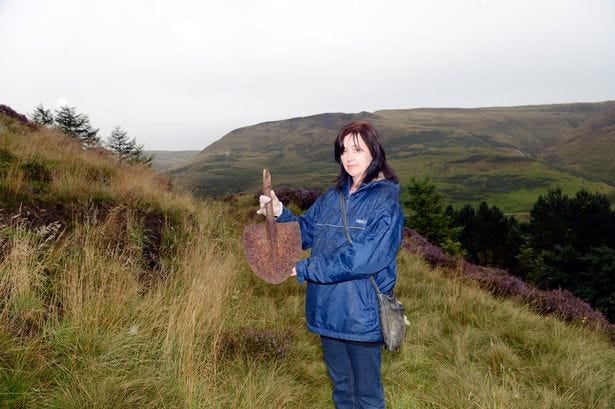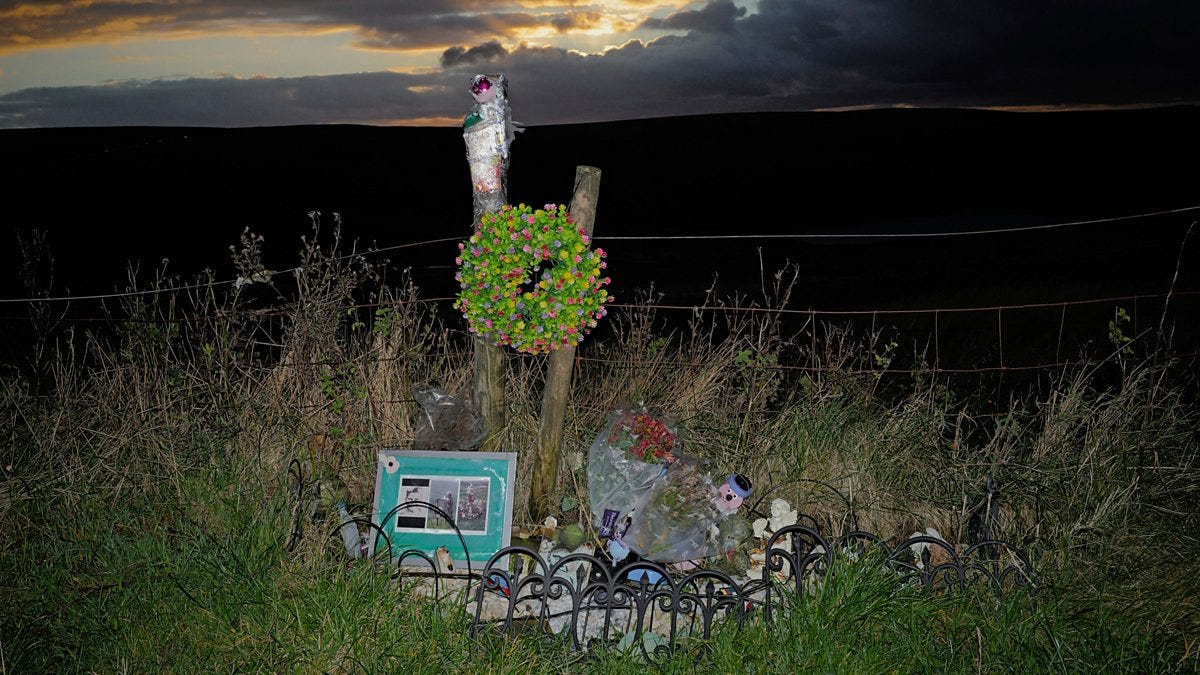Ghost Hunters on the Moors
Why Erica Gregory’s “investigation” into Keith Bennett’s murder is not harmless
Content note: This post discusses the Moors Murders, child murder, and harassment of the Bennett family (though I avoid graphic details).
Murder victim, Keith Bennett, is still missing decades after he was killed by Myra Hindley and Ian Brady. When his mother, Winnie Johnson, died in 2012 without ever knowing where her son was buried, the wave of media coverage that followed was intense and emotional. Her tireless attempts to find Keith, and Ian Brady’s refusal to reveal the location of his grave, touched and angered almost everyone who heard the story.
Around that time I said to my brother that it wouldn’t be long before ghost hunters and psychics descended on the Moors, claiming to know something nobody else knew. I didn’t think it would happen quite so quickly.
The Spade on Saddleworth Moor
In 2012, a group called Worsley Paranormal, led by Erica Gregory, made headlines by claiming to have found a spade on Saddleworth Moor that might be linked to the Moors Murders.
Gregory told the press:
“I had a feeling to search in a specific spot. The detector made a noise and we found the spade covered in grass... I’m convinced it could be linked to Keith.”
The spade was later examined by Steve Kershaw, a senior lecturer in forensic analytical science, who pointed out the obvious problems: heavy corrosion, a missing handle, peat conditions, and the extremely slim chances of any usable DNA. In other words: even if it was from the right era, there would be no way to reliably link it to Brady.
What shocked me most was not that a spade had been found (spades are not exactly rare on moorland) but that it had apparently been kept by the paranormal team rather than immediately handed to the police as potential evidence. If you honestly believe you’ve stumbled across an item connected to a notorious murder case, you do not pick it up, carry it home, and then shop it around the media and the victim’s family lawyer. You leave it where it is and call the police.
If the genuine aim was to assist with the discovery of Keith Bennett, the group should never have removed the spade, never contacted the Bennett family or their lawyer directly, and certainly never built a media narrative around it. That is the job of the police, who investigate tips on cold cases. Anything else is not “helping”; it’s interference.
This isn’t theoretical. Keith’s brother, Alan Bennett, has been very clear on the family’s position.
It should be a matter for the police alone. Therefore, we are also strongly against and wish to discourage anyone, however well-meaning, from attempting their own search of the moor, since more harm than good may well be done.
We know this from experience – in the past, damage has been done by people who didn’t have the necessary training to conduct such a search. There have also been many paranormal investigations into the location of Keith’s grave but none have proved remotely useful.
- Alan Bennett
Knowing this, it is hard to describe Worsley Paranormal’s behaviour as anything other than unethical, regardless of their intentions.
Pseudo-Science, Diplomas, and EVP
After I wrote about the spade and the ethical issues, I started looking more closely at Worsley Paranormal’s methods.
The group’s own material explains that they rely heavily on Electronic Voice Phenomena (EVP) – alleged spirit voices on audio recordings, which in practice are audio illusions created by noise and suggestion. They believe that their EVP sessions led them to Saddleworth Moor and also claim their work involves researching “missing or unnamed victims” of Brady and Hindley.

Gregory formed the group, we’re told, after taking a Diploma in Paranormal Investigation and studying “famous investigators.” This sounds impressive until you realise there is no such thing as an accredited, recognised diploma in paranormal investigation. There are plenty of paid courses, some online, some from the back of magazines, but they don’t magically confer expertise or teach ethical practice. You should be deeply skeptical of anyone waving a diploma in this field like it’s a professional qualification.
None of this would matter much if they were just playing ghost hunters in empty pubs. But they are not. They have attached themselves to one of the most sensitive and painful unsolved murder cases in modern British history.
Five Years of Emails
The first time I wrote about Worsley Paranormal was back in 2012 and it did not take long for me to start receiving emails from Erica. The first arrived on 2013, describing my criticisms as ‘stupid’ and insisting I ‘obviously have no idea about the paranormal.’ She suggested I remove my post or at least admit I was wrong and provided a link that, she claimed, would clear things up.
It didn’t. The site (now removed) simply reinforced what I already thought: this was a ghost hunting group relying on EVP, tenuous interpretations, and grand claims about the Moors, all while the family of a murdered child was asking them to stop.
Over the years that followed, Gregory continued to send me barely-legible, increasingly irate emails demanding that I take my posts down. In one 2017 message she claimed I was making ‘stupid comments’, insisted she worked ‘with detectives and ex police on the Moors Case’, and said Brady’s doctors and criminologists were using her work. She also claimed to have ‘full support from friends and family of the victims’, before dismissing Alan Bennett as ‘a bitter man’.
I got off lightly. Annoying a ghost hunter on the internet is not exactly a tragedy. The real harm has always been aimed at the people who matter most in this case: the Bennett family.
Conspiracy Code-Breaking and Ian Brady
As Worsley Paranormal’s work evolved, the claims grew stranger.
Gregory and her team say that psychic insight and EVP have helped them communicate with spirits connected to the Moors Murders. They also believe this supposed paranormal input has helped them crack a secret code hidden by Ian Brady in his book The Gates of Janus – a book that is, in reality, mostly pseudo-philosophical ramblings about crime written by a man diagnosed with paranoid schizophrenia and narcissistic personality disorder.
According to Gregory, this imagined code reveals unknown information about the murders, including the alleged location of Keith, as well as other supposed victims and hidden connections. They claim the spirits and the “code” have led them to find a motorcycle glove, polyethene, a gun, part of a rusted spade, and other odds and ends on the moor which they insist are linked to Brady.
This would only make sense if Ian Brady were the only person ever to ride a motorcycle on Saddleworth Moor, use polyethene, or carry a spade onto moorland.
He wasn’t. So this is not evidence; it is pattern-seeking.
Once you start looking at the material Worsley Paranormal put out – hours of videos, screenshots, diagrams and EVP clips – a picture emerges of classic conspiracy thinking: finding hidden messages everywhere, forcing unrelated ideas together, and spinning a web that includes Brady, Ancient Egypt, the Irish famine, Cromwell, George Orwell, Bertrand Russell and more.
Meanwhile, the one thing that actually matters – where Keith’s body is – remains unknown.
Alan Bennett attended Ian Brady’s mental health tribunal in 2013 and later wrote:
The only people that matter to Brady are himself and the people he can manipulate, and there are too many people willing to be manipulated by him.
Brady worked hard to keep himself in the spotlight from prison. People like Gregory, who decide he has left them a trail of clues to decode, helped maintain that spotlight, whether they mean to or not.
The Bennetts’ Response – and Gregory’s
Gregory has faced a lot of criticism from members of the public and from Alan Bennett himself, particularly over the way she conducts her searches” and publicises her theories.
In a review of her book, Bennett wrote:
“This group of misled and misinformed individuals still trawl the internet claiming, firstly, that they have the support of the police and then they state that they cannot understand why they are not taken seriously by the police!
Nobody with any sort of understanding of this case and the details of this case will ever take them seriously, the sooner they take that FACT in the better for all concerned.”
You would think that finding out you had deeply upset the family of a murdered child would be enough to make you stop and reflect. Instead, Gregory routinely disparages Bennett as “bitter” and “ungrateful.” According to messages he has shared publicly, she has referred to him as “an ungrateful knob” and “cheeky ungrateful moron,” apparently furious that he does not appreciate her attempts to help.
After Brady’s death in May 2017, Gregory told one outlet that her work would continue and had a message for her critics, including those close to the victims:
“To all the people who have a go at us, including some close to victims, I say to them ‘get on your boots and walk with us and help’.”
The Bennett’s have repeatedly asked people not to do this.
On their own, Erica Gregory and Worsley Paranormal would be an odd little cautionary tale about how far people can take ghost hunting when nobody tells them “no.” But they have been given space in the media to promote their claims about the Moors murders, and every time they do, journalists inevitably contact the Alan Bennett for comment.
So you have a bereaved family, already carrying the unimaginable weight of what happened to Keith, forced to endure yet another round of “a ghost hunter says they know where Keith is” stories and to deal with the fallout. You have a murder case that should be handled by professionals, not hobbyists with Dictaphones and a flare for conspiracy, and you have the legacy of Ian Brady, who thrived on attention, being kept alive by people convinced he is still secretly communicating with them from beyond the grave or between the lines of a book.
In my opinion, Erica Gregory is a fantasy-prone conspiracy theorist with a hero complex, and Worsley Paranormal is one of the worst examples of contemporary ghost hunting I’ve ever seen.
Writing about this case is never neutral work - it’s impossible not to feel the weight of what was done to these children each time I revisit this story. I thought I’d write one blog post about the spade and that would be that, but Erica routinely Googles her name, lands on my blog, and sends angry emails, so I keep coming back to this.
But I am not the important person in this story, and neither is she. The important people are the victims and their families.
Keith Bennett is still missing. His loved ones have been very clear about what they need and what they do not want. Ignoring that – and then attacking them when they object – is not helping with the case. It’s cruelty.
Sometimes, the most respectful thing a ghost hunter can do is stay away.





